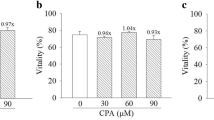Abstract
The in vivo antiandrogenicity of Casodex has been confirmed and characterised. Androgen receptor (AR) binding assays of rat ventral prostate gland cytosols revealed a relative binding affinity (RBA) for the AR of 0.267 and a k1 of 1.25 x 10(-7) M for Casodex. In addition, the peripheral selectivity of Casodex relative to other non-steroidal antiandrogens was confirmed in that daily treatment of non-castrated rats with Casodex (25 mg kg-1) did not elicit any changes in serum LH and testosterone concentrations relative to vehicle-treated controls, whereas elevated serum LH and testosterone were observed in rats treated with flutamide (25 mg kg-1). The peripheral selectivity of Casodex in the intact male rat was related to the distribution of radiolabelled antiandrogen following intravenous injection. All tissues with the exception of the hypothalamus and cerebral cortex (CC) sequestered radioactivity such that the tissue:serum ratio (TSR) for the drug was greater than unity. In the testis, the TSR was less than unity 1 h after injection but approached unity 5 h after injection and was greater than unity 10 h after injection. This may be explained by the presence of a blood-testis barrier for the drug, resulting in delayed equilibration between the blood and testis tissue. By comparison, an order of magnitude lower amounts of radioactivity in the hypothalamus and CC were maintained for the 10 h period after injection. These data, together with known physicochemical properties of Casodex suggest that a blood-brain barrier exists for the drug which results in exclusion of this antiandrogen from central sites of androgen negative feedback and that this accounts for its peripherally selective antihormonal profile.
This is a preview of subscription content, access via your institution
Access options
Subscribe to this journal
Receive 24 print issues and online access
$259.00 per year
only $10.79 per issue
Buy this article
- Purchase on Springer Link
- Instant access to full article PDF
Prices may be subject to local taxes which are calculated during checkout
Similar content being viewed by others
Author information
Authors and Affiliations
Rights and permissions
About this article
Cite this article
Freeman, S., Mainwaring, W. & Furr, B. A possible explanation for the peripheral selectivity of a novel non-steroidal pure antiandrogen, Casodex (ICI 176,334). Br J Cancer 60, 664–668 (1989). https://doi.org/10.1038/bjc.1989.336
Issue Date:
DOI: https://doi.org/10.1038/bjc.1989.336
This article is cited by
-
Evolution of the androgen-induced male phenotype
Journal of Comparative Physiology A (2018)
-
Casodex (a nonsteroidal antiandrogen) reduces cancellous, endosteal, and periosteal bone formation in estrogen-replete female rats
Calcified Tissue International (1996)
-
Pathological and morphometric assessment of testicular parameters in patients with metastatic prostate cancer following treatment with either the antiandrogen Casodex (ZM176,334) or bilateral orchidectomy
Urological Research (1994)



